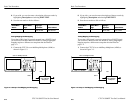
Basic Test Procedures
3–8
CTS 710 SONET Test Set User Manual
4. When the test is complete, you can store the test results to disk or
print out a hardcopy. To save the test results to disk, you must
enter a name for the disk file as follows:
Press Menu
Button
Select Menu
Page
Highlight
Parameter
Select Choice
RESULTS SAVE RESULTS Name EDIT NAME
5. Enter an eight-character name for the file.
6. If you wish, you can also enter a description of the test results by
highlighting Description and selecting EDIT TEXT.
7. Save the test results to disk as follows:
Press Menu
Button
Select Menu
Page
Highlight
Parameter
Select Choice
Save to Disk Save Current
Fault Tolerance Checking
Fault tolerance testing (sometimes called stimulus/response testing or
stress testing) is used to ensure that a network responds correctly to
various fault conditions. Though there are many additional fault
conditions you can test with the CTS 710, this section covers three
common examples:
H Response to errors and alarms
H Response to pointer movements
H Response to line frequency offset
Response to Errors and Alarms
This example uses two CTS 710s to simultaneously check the
upstream and downstream responses to an error or alarm condition.
You can use a single CTS 710 to do the same thing by alternately
Basic Test Procedures
3–8
CTS 710 SONET Test Set User Manual
4. When the test is complete, you can store the test results to disk or
print out a hardcopy. To save the test results to disk, you must
enter a name for the disk file as follows:
Press Menu
Button
Select Menu
Page
Highlight
Parameter
Select Choice
RESULTS SAVE RESULTS Name EDIT NAME
5. Enter an eight-character name for the file.
6. If you wish, you can also enter a description of the test results by
highlighting Description and selecting EDIT TEXT.
7. Save the test results to disk as follows:
Press Menu
Button
Select Menu
Page
Highlight
Parameter
Select Choice
Save to Disk Save Current
Fault Tolerance Checking
Fault tolerance testing (sometimes called stimulus/response testing or
stress testing) is used to ensure that a network responds correctly to
various fault conditions. Though there are many additional fault
conditions you can test with the CTS 710, this section covers three
common examples:
H Response to errors and alarms
H Response to pointer movements
H Response to line frequency offset
Response to Errors and Alarms
This example uses two CTS 710s to simultaneously check the
upstream and downstream responses to an error or alarm condition.
You can use a single CTS 710 to do the same thing by alternately


















